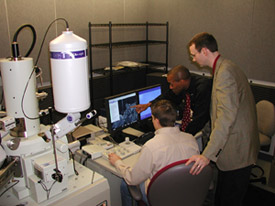
TUSCALOOSA, Ala. – Dr. Gregory B. Thompson, assistant professor of metallurgical and materials engineering at The University of Alabama, recently received a $1.3 million grant from the National Science Foundation’s Major Research Instrumentation award to purchase a new transmission electron microscope.
The microscope, a 200keV Field Emission FEI Tecnai F20 Super-twin, will allow UA scientists and engineers to study a variety of different materials at the nanometer scale to better understand their properties. A nanometer is one-billionth the length of a meter. This particular microscope can image materials at a magnification of one-million times–an ultra-high magnification that allows scientists to view individual atoms. At the atomic level, researchers are able to understand how to engineer materials to improve properties such as electrical conduction and mechanical strength.
“A tool of this caliber affords the university community a tremendous research opportunity,” Thompson said. “The analytical capability of this microscope will further strengthen the university’s research infrastructure. By characterizing the atomic structure and composition of materials, we have new opportunities to fundamentally move science and engineering forward.”
Several faculty members, who are co-investigators on this award, have already designed experiments utilizing the new microscope for research in magnetic thin films and nanoparticles for computer hard drives, thermal barrier coatings on aircraft blades, and hydrogen fuel cells for next-generation automotive propulsion.
The microscope is equipped with an atypical imaging detector, called a High Annular Angle Dark Field detector, which allows for atomic level contrast imaging between different atomic numbered materials. This helps users distinguish the image contrast between materials as a function of the type of atom. This detector also allows the microscope to do tomography imaging, which is a three-dimensional imaging technique that generates multiple viewing perspectives. By characterizing the overall shape of materials at the nanometer scale, researchers gain better insight into the structure of materials.

The microscope will be housed and maintained in UA’s Central Analytical Facility. The addition of this microscope makes The University of Alabama a premier characterization facility in the Southeast and in the nation. This tool provides the College of Engineering faculty the resources to competitively renew existing programs and win new grants and contracts by having the capability to perform atomic level structural and chemical analysis.
The investigators involved in the NSF MRI proposal for the TEM include Dr. Tonya Klein, Reichhold-Shumaker Assistant Professor of chemical and biological engineering; Dr. Gary Mankey, associate professor of physics; Dr. David Nikles, professor of chemistry and materials science; Thompson and Weaver. Additionally, several faculty members from the Colleges of Arts and Sciences and Engineering were involved as senior investigators.
In 1837, The University of Alabama became the first university in the state to offer engineering classes and was one of the first five in the nation to do so. Today, the College of Engineering has about 1,800 students and more than 95 faculty. It has been fully accredited since accreditation standards were implemented in the 1930s.
Contact
Caitlin Tudzin, Engineering Student Writer, 205/348-3051, tudzi001@bama.ua.eduMary Wymer, 205/348-6444